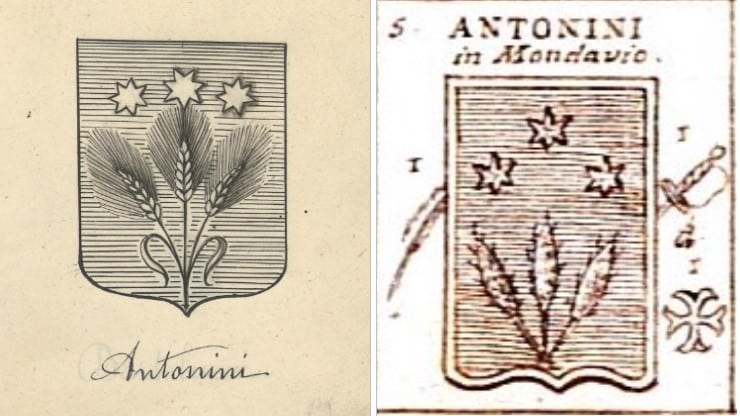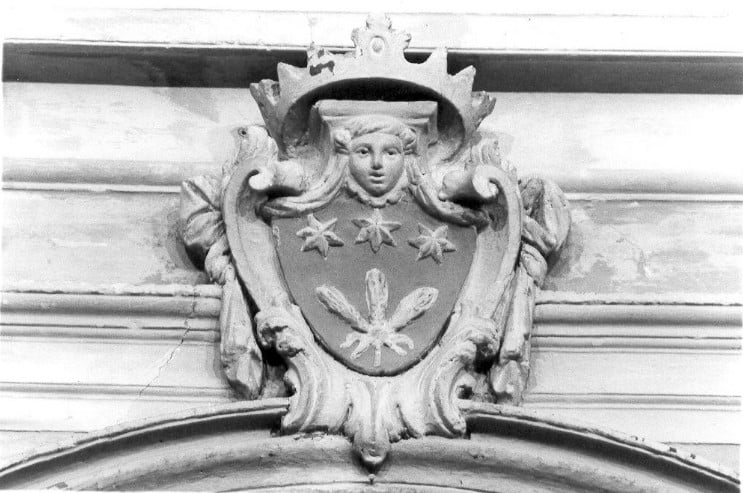- Mirror. Tuscany, second quarter of the 18th century
Mirror in carved and gilded wood. The rectangular frame that encloses the mirror is carved with motifs of small volutes on the corners with a burin-beaten background. Around the frame there is a carving decoration with architectural scrolls and leaves enriched with flowers; this decoration finds its apex in the cymatium, where the lateral volutes are embellished with lambrequins while in the center there is a screaming mask which forms the basis for housing an engraved mirror; it is the heraldic coat of arms of the Antonini family, made up of three ears of wheat held by a fluttering ribbon, placed under three eight-pointed stars. The gouache gilding maintains the contrast between the opaque backgrounds and the parts in relief polished with agate. The mirrors are antique mercury.
Dimensions: cm. 167x120x34
CODE: ANCOSP0192815
This mirror was probably made in the second quarter of the eighteenth century. In fact, while maintaining all the character of the Baroque mirrors of the early 18th century, it presents lightness and freedom that are already the result of an infection with the new Baroque taste.
The almost calligraphic carving in the corners of the frame, which at the beginning of the century used to reproduce Jean Berain’s motifs sharply, here becomes softer and sweeter; even the cascades of volutes and flowers that make up the sides lack the symmetrical rigidity that characterizes the first works of the century.

Compared to the attribution to the Antonini family, some documents relating to the noble families present in the Fano area are fundamental, containing the noble shield distinguished by three ears of wheat tied by a ribbon and placed under as many eight-pointed stars.
The first, a manuscript entitled “Coats of noble families of Fano collected for news of posterity” written by Francesco Bertozzi in 1705 and kept in the Domenico Federici Fund, the second, a group of drawings from 1764 entitled “Coats of noble families: Noble families present who reside in the city of Fano” by Onofrio Gramignani and kept in a private collection (Giuseppe Castellani Collection). According to the writings of Francesco Seta (De Santi, 2010), a seventeenth-century historian, the Antoninis, a family originally from the Faenza area, are attested both in the Marche region and in the province of Pistoia in Tuscany, in the area of the “Macchia Antonini” and neighboring.
It should be noted that a very similar mirror is published by Enrico Colle (Colle, 2009) in “Il mobile lucchese”.

Comparison biography
• Colle E., Il Mobile Lucchese. Dal Cinquecento all’Ottocento, maria pacini fazzi editore, Lucca, 2009, p. 143, Tav. LI.
• Seta F., Della nobiltà e gentilezza, 1629, dato alle stampe da Giovanni Antonini (Palustro Infecondo) nel 1684 (in “Pillole di Storia” di De Santi C., 2010).
• Bertozzi F., Blasoni delle famiglie nobili di Fano raccolti per notizia dei posteri, Fano, 1705, p. 138.
• Gramignani O., Stemmi di famiglie nobili: Nobili famiglie presenti che risiedono nella città di Fano, 1764.

FineArt is the new ambitious Di Mano in Mano project that offers an exclusive choice of antiques and design works, presenting them for their singularity and uniqueness.

FineArt by Di Mano in Mano is a team of experts at your service to enhance furniture, paintings, finest antiques, art and design masterpieces at best.
Di Mano in Mano
Via Castellazzo 8, Cambiago (MI)
20040